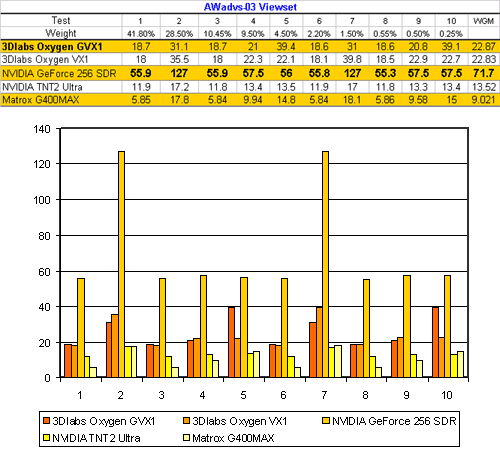Advanced Visualizer (AWadvs-03) Viewset
Taken from http://www.spec.org/gpc/opc.static/awadvs.htm
Advanced Visualizer from Alias/Wavefront is an integrated workstation-based 3D animation system that offers a comprehensive set of tools for 3D modeling, animation, rendering, image composition, and video output. All operations within Advanced Visualizer are performed in immediate mode with double buffered windows. There are four basic modes of operation within Advanced Visualizer:
These are the 10 tests specified by the viewset that represent the most common operations performed by Advanced Visualizer:
- 55% material shading (textured, z-buffered, backface-culled, 2 local lights)
- 95% perspective, 80% trilinear mipmapped, modulated (41.8%)
- 95% perspective, 20% nearest, modulated (10.45%)
- 5% ortho, 80% trilinear mipmapped, modulated (2.2%)
- 5% ortho, 20% nearest, modulated (.55%)
- 30% wireframe (no z-buffering, no lighting)
- 95% perspective (28.5%)
- 5% ortho (1.5%)
- 10% smooth shading (z-buffered, backface-culled, 2 local lights)
- 95% perspective (9.5%)
- 5% ortho (.5%)
- 5% flat shading (z-buffered, backface-culled, 2 local lights)
- 95% perspective (4.75%)
- 5% ortho (.25%)
Test Weight Advanced Visualizer functionality represented 1 41.8% Material shading of polygonal animation model with highest interactive image fidelity and perspective projection. 2 28.5% Wireframe rendering of polygonal animation model with perspective projection. 3 10.45% Material shading of polygonal animation model with lowest interactive image fidelity and perspective projection. 4 9.5% Smooth shading of polygonal animation model with perspective projection. 5 4.75% Flat shading of polygonal animation model with perspective projection. 6 2.2% Material shading of polygonal animation model with highest interactive image fidelity and orthogonal projection. 7 1.5% Wireframe rendering of polygonal animation model with orthogonal projection. 8 .55% Material shading of polygonal animation model with lowest interactive image fidelity and orthogonal projection. 9 .5% Smooth shading of polygonal animation model with orthogonal projection. 10 .25% Flat shading of polygonal animation model with orthogonal projection.

The GeForce simply dominates here. The reason being because of the nature of this viewset, it is heavily dependent on having a high fill rate (480Mpixels/sec for the GeForce) and also benefits quite nicely from NVIDIA's superior hardware T&L capabilities. What you'll find is that there are certain applications that truly allow the power of the $300 GeForce's GPU to stand out, but in others it fails without a doubt.
The Oxygen GVX1 performs respectably here, in some cases it falls behind the old VX1 simply due to benchmarking variations and a lack of driver optimizations. It should also be noted that the 3Dlabs Application Configuration Control Panel was set to default OpenGL during this test, some of the other settings could provide for greater performance but realistically, the GeForce isn't going to be touched in this particular test.

The Weighted Geometic Mean says it all, the GeForce's powerful GPU and high fill rate do give it a very large advantage here at a very affordable cost. The GVX1 simply can't compete with this gamer's card, even in its own professional environment. But let's move on to the next viewset to see how things change...










3 Comments
View All Comments
evilpaul666 - Wednesday, October 14, 2020 - link
First!Railgun - Thursday, October 15, 2020 - link
Welp, if we’re going to be children...First is worst. Second’s best.
domboy - Thursday, October 15, 2020 - link
Reading this all these years later I realize several things. I miss- single slot cards
- having more than just two gpu vendors
- video cards with green PCBs
Good old PCI bus. I don't miss AGP though... glad PCIe came along to to allow one standard for all add-on cards.